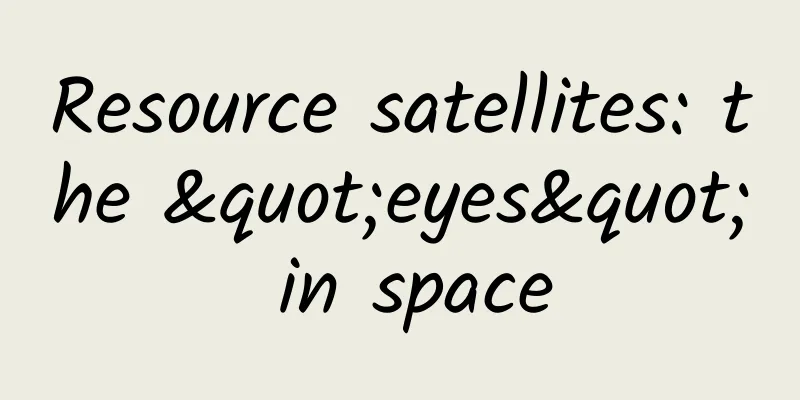Resource satellites: the "eyes" in space

|
Resource satellites are China's earliest transmission-type civilian remote sensing satellites. They were created to break the foreign monopoly on satellite remote sensing images. The first generation of resource satellites was jointly developed by China and Pakistan and is hailed as a model of South-South cooperation. Today, three generations of resource satellites have been launched, namely Resource 1, Resource 2 and Resource 3, with their performance gradually improving. In each generation of satellites, the later satellites have also been improved to varying degrees. Unlike the Gaofen series, the Ziyuan series are mainly based on visible light remote sensing and fly in a low earth orbit of about 800 kilometers. Together, these two series constitute the "national team" of China's earth observation satellites. my country's resource satellite family There are currently five Resource-1 satellites launched. Among them, 01/02 satellites were jointly developed by China and Pakistan. 01 satellite was launched on October 14, 1999, ending my country's long history of not having its own resource satellite. 02 satellite was successfully launched on October 21, 2003. The basic parameters of these two satellites are similar to those of Midea Landsat V, and the resolution of the main camera is 20 meters. Resource-1 satellite 02B satellite was launched on September 19, 2007 and successfully entered orbit. The resolution of its main camera was greatly improved to 2.36 meters, breaking the long-term monopoly of foreign countries on high-resolution satellite data. 02C satellite was successfully launched on December 22, 2011. It carries two 2.36-meter resolution main cameras, which greatly improves data coverage capabilities. In addition, 02C satellite carries a 10-meter resolution multispectral camera, enriching the data type. Schematic diagram of Resource-1 02C satellite When Ziyuan-1 03 was launched on December 9, 2013, it failed to enter the planned orbit due to a rocket failure. Ziyuan-1 04 completed the mission that 03 failed to complete on December 7, 2014. It did not carry a high-resolution visible light camera, but a panchromatic multispectral camera with a spatial resolution of 5 meters/10 meters and an infrared multispectral scanner with a spatial resolution of 40 meters/80 meters. In addition, it also carried a 20-meter resolution multispectral camera and a 73-meter resolution wide-field imager developed by Brazil. The Resource-1 satellite has a very prominent feature, it has only one solar wing. This is rare among domestic satellites. At that time, foreign remote sensing satellites also adopted a similar configuration. This is mainly because the camera of the resource satellite is sensitive to temperature, so the thermal control requirements of the satellite are relatively high, and a large thermal radiator needs to be equipped on the star. The thermal radiator must face the space, so it occupies the position where the second solar wing could have been set. Subsequent resource satellites have adopted a pair of solar wings due to technological advances and program improvements. Ziyuan-2 is also a transmission-type remote sensing satellite, one of which was launched in September 2000 and one on October 27, 2002. Ziyuan-3 is my country's first civilian high-resolution optical transmission stereo mapping satellite, which can not only investigate earth resources, but also has surveying and mapping capabilities. Ziyuan-3 is equipped with front, rear and front cameras, which can take pictures of the same area from three different observation angles to form a stereo image pair. Ziyuan-3 satellite image data The first Ziyuan-3 satellite was successfully launched on January 9, 2012. The 02 satellite was launched on May 30, 2016, realizing China's first independent civilian stereo mapping dual-satellite network operation. The 02 satellite stereo image resolution has been increased from 3.5 meters of the 01 satellite to 2.5 meters, which can serve 1:50,000 and 1:25,000 scale stereo mapping. The 03 satellite was successfully launched on July 25, 2020. Domestic Application of Resource Satellites Since the resource satellite was put into orbit, it has provided a large amount of data to various user units, providing important support for urban planning, agricultural production, forestry maintenance, road selection, emergency rescue and other fields. Especially with the launch of Resources-1, the then Ministry of Land and Resources and other units launched a domestic data application demonstration project, and united almost all domestic remote sensing application industries and application units to jointly explore the role of resource satellite data in remote sensing applications, vigorously promote import substitution, and initially form a domestic remote sensing satellite data application system, paving the way for the subsequent application of resource satellites. Especially in the response to geological disasters, the resource satellite has played its advantages in space observation, and has fully observed dangerous situations in scenes such as the Ya'an earthquake, the Zhouqu landslide and debris flow disaster, the Jinsha River barrier lake, the Laos flood and forest fire, and has contributed to the design of risk elimination plans. In early March 2022, the Resource-3 03 satellite participated in the observation of forest fires in Medog County, Linzhi, the Salt Lake District of Yuncheng, Shanxi, and Mianning County, Liangshan Prefecture, Sichuan. The images were provided to the Science and Technology and Informatization Department of the Ministry of Emergency Management, the Land Satellite Remote Sensing Application Center of the Ministry of Natural Resources, and the Forest Fire Early Warning Monitoring Information Center. Resource satellites are also being promoted and applied at the provincial level, providing support for special applications such as ecological environment management, farmland occupation and re-demarcation in Jiangsu, Zhejiang, Shandong and other places. The International Impact of Resource Satellites The application of resource satellites has also had a wide-ranging impact internationally. In May 2007, the Chinese government joined the International Charter on Space and Major Disasters with its Resource Satellite series, and undertook the obligation to provide monitoring services for major global disasters. Resource Satellites, together with other satellites such as Canada's RadarSat, Europe's ERS satellite, and France's SPOT satellite, became free data sources for the Charter. After China joined the Charter, Resource Satellites responded to and handled international requests for major natural disasters many times, and provided assistance for the forecasting and rescue of major natural disasters worldwide. After China joined the Group on Earth Observations, the world's largest intergovernmental Earth observation organization, the Resource Satellite series participated in the sample data set of domestic land observation satellites, and Resource-1 04 provided data to help promote the Global Forest Observation Program. In 2007, at the fourth plenary session and the fourth ministerial summit of the Group on Earth Observations (GEO), Wan Gang, Minister of Science and Technology, announced the decision to share the data of CBERS-02B in Africa. The China Resources Satellite Application Center was authorized to establish a CBERS-02B data receiving station in South Africa to process, store and distribute data, and to further promote it in other African countries after achieving results. The resource satellite also established a data receiving station in South Africa. In early 2009, the reception and processing system of Resource-1 02B satellite in South Africa was put into operation, achieving a breakthrough in the overseas landing and distribution of Chinese resource satellite data. In April 2010, the Chinese and Brazilian governments signed the "China-Brazil Earth Resources Satellite Data Global Data Distribution Agreement". In December 2010, the Chinese and Brazilian operators and South Africa signed a memorandum of understanding on the reception and distribution of data from Resource-1 04 satellite in South Africa at the inauguration ceremony of the South African Space Agency. On December 2, 2015, China and South Africa officially signed the final delivery agreement for the South African ground system of Resource-1 04 satellite, and the South African ground system was officially put into operation. This ground station has given 13 countries in southern Africa the opportunity to use resource satellite data in areas such as desert control, land use, resource development, natural disaster and ecological environment monitoring, and the construction of urban and transportation infrastructure. (Author: Chi Huo) |
<<: Black sesame pills may not save your hair loss! What is the real secret to growing hair?
Recommend
Are you always getting electrocuted in winter? Here are some easy tips to help you avoid static electricity!
Winter is coming Do you often experience sudden &...
Jie Xiaojie · Popular methods and techniques course videos on short videos
The course is about the techniques and methods of...
Douyin mini-game blue ocean project, earning 5000+ a day without fans
The 15th strategy of the three crazy demolishers ...
What kind of evolutionary history did the "leader" of the Paleozoic Era experience?
When it comes to paleontology, many people may th...
GAC Aion has taken the lead in applying for L3 autonomous driving
Recently, the Ministry of Industry and Informatio...
Why are developers cheap on iOS but valuable on GitHub?
Editor's note: Recently, two major events clo...
Eating more dietary fiber can help reduce inflammation levels in the body! Which foods have good anti-inflammatory effects?
Inflammation is the common "soil" for m...
QQ's new emoticon "Da Cai Wang" dominates the screen: no matter how big the phone screen is, it will never be blurred
Recently, Tencent Mobile QQ has launched version ...
Does smoking affect your appearance? It’s true!
Author: Xiao Dan, Director of the Department of T...
How to use the reverse method to improve the bidding effect of Baidu?
Generally, data analysis is done step by step fro...
Android Wear is also about to be upgraded to 5.0, and the watch face display mode is turned on
In this era of personalization, you may also thin...
Wuwei Investment Class "Professional Investor Training Camp"
Wuwei Investment Classroom "Professional Inv...
Why has China Merchants Bank’s micro-customer service become an industry benchmark?
According to sources, on November 5, the number o...
The tap water in residents' homes is yellow! How did the tap water change color?
Many residents have reported that their tap water...
Can you buy expensive skin care products for a small price? Are the "substitutes" of big brands really reliable?
Are the big-name skincare products that cost tens...









